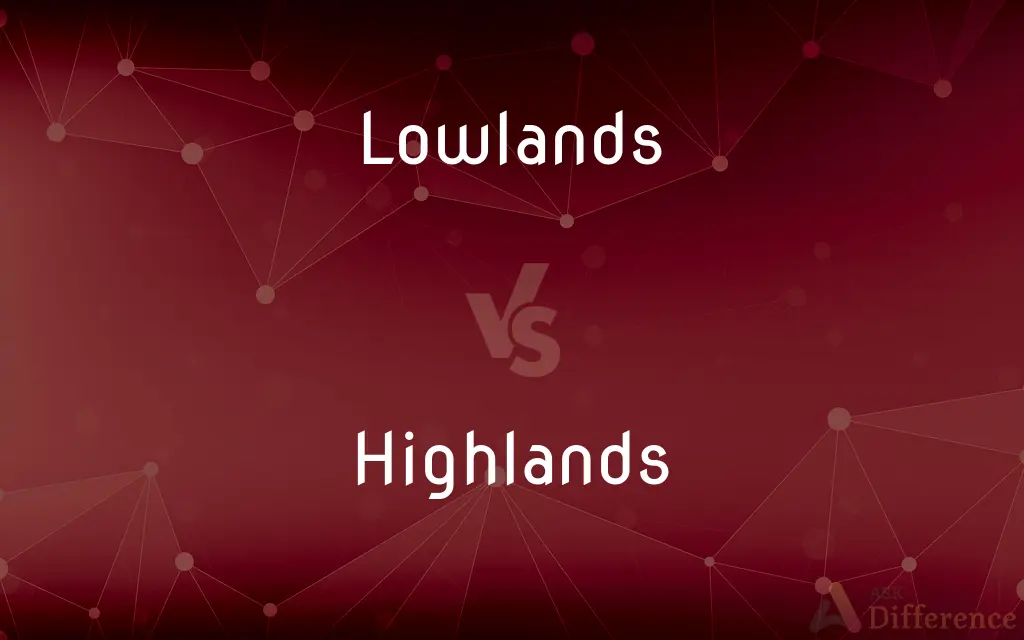Lowlands vs. Highlands — What's the Difference?
By Maham Liaqat & Urooj Arif — Updated on March 26, 2024
Lowlands are areas of low elevation, often characterized by flat terrain and fertile soils, while highlands are elevated regions, known for mountainous landscapes and cooler climates.

Difference Between Lowlands and Highlands
Table of Contents
ADVERTISEMENT
Key Differences
Lowlands are regions where the elevation is relatively low compared to the surrounding areas, often resulting in flat or gently rolling terrain. These areas are typically known for their agricultural productivity due to fertile soils and more temperate climates. For example, the Netherlands is famous for being a lowland country with much of its land below sea level. Highlands, on the other hand, are areas of high elevation, usually characterized by mountainous terrain. They often have cooler climates and less arable land due to steep slopes and rocky soil. The Scottish Highlands are a prime example, known for their rugged landscape and cultural distinctiveness.
While lowlands are often associated with larger populations due to their agricultural and economic advantages, highlands tend to have lower population densities. The challenging terrain and cooler climate of highlands can make them less suitable for intensive farming and urban development.
Lowlands are typically more accessible and have been centers for commerce, development, and settlement throughout history. This accessibility contributes to their role as economic hubs. Highlands, whereas, are often valued for their natural beauty, offering opportunities for tourism and recreation despite their less hospitable terrain for urban expansion.
Culturally, both lowlands and highlands have distinct identities, often shaped by the landscape. Lowland areas may emphasize agricultural heritage, while highland cultures might be more influenced by the isolation and natural environment, leading to unique traditions, languages, and ways of life.
Comparison Chart
Elevation
Low, often close to sea level.
High, often mountainous.
ADVERTISEMENT
Terrain
Flat or gently rolling.
Mountainous, rugged.
Climate
More temperate, conducive to agriculture.
Cooler, less conducive to agriculture.
Population Density
Typically higher.
Typically lower.
Economic Activity
Agriculture, commerce, and settlement.
Less agriculture, more tourism and recreation.
Accessibility
More accessible, facilitating development.
Less accessible, challenging terrain.
Cultural Identity
Often agricultural heritage.
Influenced by isolation and natural surroundings.
Compare with Definitions
Lowlands
Regions characterized by fertile soils.
The river lowlands are teeming with crop fields.
Highlands
Often densely populated due to favorable living conditions.
The lowlands house the majority of the nation's population.
Lowlands
Prone to flooding in certain geographical locations.
The coastal lowlands experience seasonal flooding.
Highlands
Regions characterized by fertile soils.
The river lowlands are teeming with crop fields.
Lowlands
Often densely populated due to favorable living conditions.
The lowlands house the majority of the nation's population.
Highlands
Elevated regions often featuring mountainous landscapes.
The highlands offer breathtaking views and challenging hikes.
Lowlands
Economic centers due to accessibility and agricultural productivity.
The lowlands host vibrant markets and trade centers.
Highlands
Culturally distinct, often with unique traditions.
The highlands are known for their traditional music and festivals.
Lowlands
Areas of low elevation with flat terrain.
The lowlands are crucial for the country's agriculture.
Highlands
Economic centers due to accessibility and agricultural productivity.
The lowlands host vibrant markets and trade centers.
Lowlands
Plural of lowland
Highlands
Cooler climates due to higher elevations.
Summers in the highlands are mild and pleasant.
Lowlands
The southern part of Scotland that is not mountainous
Highlands
Less arable land, impacting agricultural practices.
Highland farming focuses on livestock rather than crops.
Highlands
Areas of low elevation with flat terrain.
The lowlands are crucial for the country's agriculture.
Highlands
Areas of natural beauty, attracting tourism.
Tourists flock to the highlands for their scenic beauty and outdoor activities.
Highlands
Prone to flooding in certain geographical locations.
The coastal lowlands experience seasonal flooding.
Common Curiosities
What are lowlands?
Lowlands are areas of low elevation, typically featuring flat or gently rolling terrain and fertile soils.
How does the terrain influence the economy of lowlands and highlands?
The flat terrain of lowlands supports agriculture and commerce, while highlands attract tourism due to their natural beauty.
What are highlands?
Highlands are elevated regions, often mountainous, with cooler climates and rugged landscapes.
What makes lowlands more populated than highlands?
Lowlands offer more arable land and are more accessible, making them more suitable for settlement and agriculture.
What cultural differences exist between lowlands and highlands?
Cultural differences are shaped by the environment, with lowlands often having agricultural traditions and highlands preserving unique customs due to isolation.
Why are highlands considered less accessible?
The rugged, mountainous terrain of highlands makes them less accessible compared to the flat terrain of lowlands.
Can living in highlands affect health?
Yes, the thinner air and cooler climate in highlands can affect health, often positively by offering a cleaner environment.
How do lowlands differ from highlands in terms of agriculture?
Lowlands often have fertile soils suitable for diverse crops, while highlands have less arable land, mainly suited for livestock.
Why are highlands cooler than lowlands?
Highlands are cooler due to their higher elevation, which affects temperature and climate.
Are there examples of civilizations thriving in lowlands?
Yes, many ancient civilizations thrived in lowland areas due to the availability of fertile land and water resources.
Can both lowlands and highlands be prone to natural disasters?
Yes, lowlands are prone to flooding, while highlands face risks like landslides.
How does elevation affect the climate in highlands?
Higher elevation in highlands leads to cooler temperatures and different precipitation patterns compared to lowlands.
What types of recreation are popular in highlands?
Hiking, mountain biking, and skiing are popular recreational activities in highland areas.
How do lowlands contribute to a country's economy?
Lowlands often contribute through agriculture, industry, and serving as economic hubs due to their accessibility.
What role do lowlands play in global food production?
Lowlands play a crucial role in global food production due to their extensive agricultural activities and fertile soils.
Share Your Discovery

Previous Comparison
Outlet vs. Socket
Next Comparison
Fetch vs. GetAuthor Spotlight
Written by
Maham LiaqatCo-written by
Urooj ArifUrooj is a skilled content writer at Ask Difference, known for her exceptional ability to simplify complex topics into engaging and informative content. With a passion for research and a flair for clear, concise writing, she consistently delivers articles that resonate with our diverse audience.















































